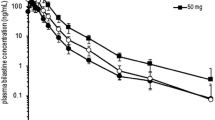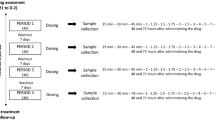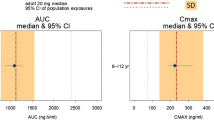Abstract
Azelastine hydrochloride is a potent second-generation antihistamine, available in Europe and the USA as a nasal spray formulation for the treatment of allergic rhinitis symptoms. GlaxoSmithKline (GSK) Consumer Healthcare has developed a new nasal formulation of azelastine hydrochloride. The present study was aimed at comparing the clinical pharmacokinetic profiles and assessing the bioequivalence of the new formulation of azelastine hydrochloride with a marketed reference nasal spray product. This was a randomized, two-way crossover, two-stage, single-dose pharmacokinetic study with 2 weeks washout between the two treatment periods. A dosage of 0.28 mg of the test and reference products was administered as a single dose to healthy volunteers according to the crossover design. Twenty-three subjects (15 subjects from stage 1 and 8 subjects from stage 2) were enrolled in the study. Adjusted mean values for AUC0–t were 1,526.8 h pg/mL for the test drug and 1,441.5 h pg/mL for the reference drug; for C max the values were 61.59 pg/mL for the test drug and 58.21 pg/mL for the reference drug. The 94.12 % CI of geometric mean ratios (test/reference) were 0.99–1.13 and 0.95–1.18 for AUC0–t and C max. This met the predefined criteria for bioequivalence between test and reference drugs. Secondary pharmacokinetic parameters for azelastine and for the metabolite desmethyl azelastine, AUC(0–∞) and t max, were numerically similar between the two study treatments. Both test and reference azelastine hydrochloride formulations were well tolerated at single dose. This study demonstrated the bioequivalence between the new azelastine hydrochloride nasal spray formulation and the marketed reference Allergodil® after single-dose administration.


Similar content being viewed by others
References
Bousquet J, Khaltaev N, Cruz AA et al (2008) Allergic rhinitis and its impact on asthma (ARIA) 2008 update (in collaboration with the World Health Organization, GA(2)LEN and AllerGen). Allergy 63:8–160
Casale TB (1989) The interaction of azelastine with human lung histamine H1, beta, and muscarinic receptor binding sites. J Allergy Clin Immunol 83:771–776
Cawello W (1999) Parameters for compartment-free pharmacokinetics. Shaker, Aachen
Chand N, Pillar J, Nolan K, Diamantis W, Sofia RD (1989) Inhibition of allergic and nonallergic leukotriene C4 formation and histamine secretion by azelastine: implications for its mechanism of action. Int Arch Allergy Appl Immunol 90:67–70
Ciprandi G, Pronzato C, Passalacqua G et al (1996) Topical azelastine reduces eosinophil activation and intercellular adhesion molecule-I expression on nasal epithelial cells: an anti-allergic activity. J Allergy Clin Immunol 98:1088–1096
Hills M, Armitage P (1979) The two period cross-over clinical trial. Br J Clin Pharmacol 8:7–20
Hollander M, Wolfe DA (1973) Nonparametric statistical methods. Wiley, New York
Ito H, Nakamura Y, Takagi S, Sakai K (1998) Effects of azelastine on the level of serum interluekin-4 and soluble CD23 antigen in the treatment of nasal allergy. Arzneimittelforschung 48:1143–1147
Nieber K, Baumgarten C, Rathsack R, Furkert J, Laake E, Müller S, Kunkel G (1993) Effect of azelastine on substance P content in bronchoalveolar and nasal lavage fluids of patients with allergic asthma. Clin Exp Allergy 23:69–71
Potvin D, DiLiberti CE, Hauck WW, Parr AF, Schuirmann DJ, Smith RA (2007) Sequential design approaches for bioequivalence studies with crossover designs. Wiley InterScience (www.interscience.wiley.com), Pharmaceutical statistics. doi: 10.1002/pst.294
Shinoda M, Watanabe N, Suko T, Mogi G, Takeyama M (1997) Effects of anti-allergic drugs on substance P (SP) and vasoactive intestinal peptide (VIP) in nasal secretions. Am J Rhinol 11:237–241
Wallace DV, Dykewicz MS, Bernstein DI et al (2008) Diagnosis and management of rhinitis: an updated practice parameter. J Allergy Clin Immunol 122:S1–S84
Zechel HJ, Brock N, Lenke D, Achterrath-Tuckermann U (1981) Pharmacological and toxicological properties of azelastine, a novel anti-allergic agent. Arzneimittelforschung 31:1184–1193
Acknowledgments
The authors appreciate the excellent help in preparing the manuscript and support of the study by Renata Perego, Elena Tedeschi and Sharron Ashburner. We also thank Dr. Nick P. Kronfield and Mairead North for their critical discussion of the study design and manuscript review. This study was sponsored by GlaxoSmithKline Consumer Healthcare.
Author information
Authors and Affiliations
Corresponding author
Rights and permissions
About this article
Cite this article
Du, D., Targett, D., Stolberg, E. et al. A clinical pharmacokinetic study comparing two azelastine hydrochloride nasal formulations in a single-dose design. Eur J Drug Metab Pharmacokinet 39, 69–75 (2014). https://doi.org/10.1007/s13318-013-0134-0
Received:
Accepted:
Published:
Issue Date:
DOI: https://doi.org/10.1007/s13318-013-0134-0




